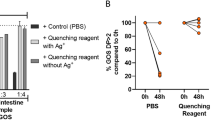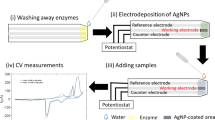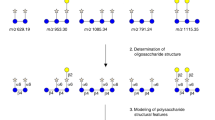Abstract
Carbohydrate digestion in the mammalian gastrointestinal tract is catalyzed by α-amylases and α-glucosidases to produce monosaccharides for absorption. Inhibition of these enzymes is the major activity of the drugs acarbose and miglitol, which are used to manage diabetes. Furthermore, delaying carbohydrate digestion via inhibition of α-amylases and α-glucosidases is an effective strategy to blunt blood glucose spikes, a major risk factor for developing metabolic diseases. Here, we present an in vitro protocol developed to accurately and specifically assess the activity of α-amylases and α-glucosidases, including sucrase, maltase and isomaltase. The assay is especially suitable for measuring inhibition by compounds, drugs and extracts, with minimal interference from impurities or endogenous components, because the substrates and digestive products in the enzyme activity assays are quantified directly by high-performance anion-exchange chromatography with pulsed amperometric detection (HPAE-PAD). Multiple enzyme sources can be used, but here we present the protocol using commercially available human α-amylase to assess starch hydrolysis with maltoheptaose as the substrate, and with brush border sucrase-isomaltase (with maltase, sucrase and isomaltase activities) derived from differentiated human intestinal Caco-2(/TC7) cells to assess hydrolysis of disaccharides. The wet-lab assay takes ~2–5 h depending on the number of samples, and the HPAE-PAD analysis takes 35 min per sample. A full dataset therefore takes 1–3 d and allows detection of subtle changes in enzyme activity with high sensitivity and reliability.
This is a preview of subscription content, access via your institution
Access options
Access Nature and 54 other Nature Portfolio journals
Get Nature+, our best-value online-access subscription
$29.99 / 30 days
cancel any time
Subscribe to this journal
Receive 12 print issues and online access
$259.00 per year
only $21.58 per issue
Buy this article
- Purchase on Springer Link
- Instant access to full article PDF
Prices may be subject to local taxes which are calculated during checkout






Similar content being viewed by others
Data availability
The data that support the anticipated results are available on figshare at https://figshare.com/articles/dataset/Barber_et_al_Nature_Protocols_Source_Data_-_Figure_4_xlsx/19709740, https://figshare.com/articles/dataset/Barber_et_al_Nature_Protocols_Source_Data_-_Figure_5_xlsx/19709890 and https://figshare.com/articles/dataset/Barber_et_al_Nature_Protocols_Source_Data_-_Figure_6_xlsx/19709896. Source data are provided with this paper.
References
Robyt, J. in Glycoscience (eds Fraser-Reid, B. O., Tatsuta, K. & Thiem, J.) Ch. 35 (Springer, 2008).
Barber, E., Houghton, M. J. & Williamson, G. Flavonoids as human intestinal α-glucosidase inhibitors. Foods 10, 1939 (2021).
Rose, D. R., Chaudet, M. M. & Jones, K. Structural studies of the intestinal alpha-glucosidases, maltase-glucoamylase and sucrase-isomaltase. J. Pediatr. Gastroenterol. Nutr. 66, S11–S13 (2018).
Lin, A. H., Hamaker, B. R. & Nichols, B. L. Jr. Direct starch digestion by sucrase-isomaltase and maltase-glucoamylase. J. Pediatr. Gastroenterol. Nutr. 55, S43–S45 (2012).
Miyake, T., Sakai, S. & Shibuya, T. Process for producing a high-purity isomaltose. US patent 4,521,252 (1981).
Livesey, G. et al. Dietary glycemic index and load and the risk of type 2 diabetes: assessment of causal relations. Nutrients 11, 1436 (2019).
McIver, L. A., Preuss, C. V. & Tripp, J. in StatPearls (StatPearls Publishing, 2022); https://www.ncbi.nlm.nih.gov/books/NBK493214/
Aryaeian, N., Sedehi, S. K. & Arablou, T. Polyphenols and their effects on diabetes management: a review. Med. J. Islam. Repub. Iran. 31, 134 (2017).
Al-Duhaidahawi, D., Hasan, S. A. & Al-Zubaidy, H. F. S. Flavonoids in the treatment of diabetes clinical outcomes and mechanism to ameliorate blood glucose levels. Curr. Diabetes Rev. 17, e120720188794 (2020).
Priscilla, D. H., Roy, D., Suresh, A., Kumar, V. & Thirumurugan, K. Naringenin inhibits alpha-glucosidase activity: a promising strategy for the regulation of postprandial hyperglycemia in high fat diet fed streptozotocin induced diabetic rats. Chem. Biol. Interact. 210, 77–85 (2014).
Visvanathan, R., Houghton, M. J. & Williamson, G. Maltoheptaoside hydrolysis with chromatographic detection and starch hydrolysis with reducing sugar analysis: comparison of assays allows assessment of the roles of direct alpha-amylase inhibition and starch complexation. Food Chem. 343, 128423 (2021).
Visvanathan, R. et al. Critical review on conventional spectroscopic alpha-amylase activity detection methods: merits, demerits, and future prospects. J. Sci. Food Agric. 100, 2836–2847 (2020).
Nyambe-Silavwe, H. et al. Inhibition of human α-amylase by dietary polyphenols. J. Funct. Foods 19, 723–732 (2015).
Hizukuri, S., Takeda, Y., Yasuda, M. & Suzuki, A. Multi-branched nature of amylose and the action of debranching enzymes. Carbohydr. Res. 94, 205–213 (1981).
John, M., Schmidt, J. & Kneifel, H. Iodine-maltosaccharide complexes: relation between chain-length and colour. Carbohydr. Res. 119, 254–257 (1983).
Robyt, J. F. & Whelan, W. J. Reducing value methods for maltodextrins. I. Chain-length dependence of alkaline 3,5-dinitrosalicylate and chain-length independence of alkaline copper. Anal. Biochem. 45, 510–516 (1972).
Teixeira, R. S., da Silva, A. S., Ferreira-Leitao, V. S. & da Silva Bon, E. P. Amino acids interference on the quantification of reducing sugars by the 3,5-dinitrosalicylic acid assay mislead carbohydrase activity measurements. Carbohydr. Res 363, 33–37 (2012).
Cheng, M. W. et al. Different sucrase-isomaltase response of Caco-2 cells to glucose and maltose suggests dietary maltose sensing. J. Clin. Biochem. Nutr. 54, 55–60 (2014).
Pyner, A., Nyambe-Silavwe, H. & Williamson, G. Inhibition of human and rat sucrase and maltase activities to assess antiglycemic potential: optimization of the assay using acarbose and polyphenols. J. Agric. Food Chem. 65, 8643–8651 (2017).
Quezada-Calvillo, R. et al. Contribution of mucosal maltase-glucoamylase activities to mouse small intestinal starch alpha-glucogenesis. J. Nutr. 137, 1725–1733 (2007).
Amiri, M. & Naim, H. Y. Characterization of mucosal disaccharidases from human intestine. Nutrients 9, 1106 (2017).
Simsek, M., Quezada-Calvillo, R., Ferruzzi, M. G., Nichols, B. L. & Hamaker, B. R. Dietary phenolic compounds selectively inhibit the individual subunits of maltase-glucoamylase and sucrase-isomaltase with the potential of modulating glucose release. J. Agric. Food Chem. 63, 3873–3879 (2015).
Visvanathan, R. & Williamson, G. Citrus polyphenols and risk of type 2 diabetes: evidence from mechanistic studies. Crit. Rev. Food Sci. Nutr. https://doi.org/10.1080/10408398.2021.1971945 (2021).
Da Silva, D. et al. Antidiabetic activity of Sedum dendroideum: metabolic enzymes as putative targets for the bioactive flavonoid kaempferitrin. IUBMB Life 66, 361–370 (2014).
Pyner, A., Chan, S. Y., Tumova, S., Kerimi, A. & Williamson, G. Indirect chronic effects of an oleuropein-rich olive leaf extract on sucrase-isomaltase in vitro and in vivo. Nutrients 11, 1505 (2019).
Lim, J., Zhang, X., Ferruzzi, M. G. & Hamaker, B. R. Starch digested product analysis by HPAEC reveals structural specificity of flavonoids in the inhibition of mammalian alpha-amylase and alpha-glucosidases. Food Chem. 288, 413–421 (2019).
Rocklin, R. D. & Pohl, C. Determination of carbohydrates by anion exchange chromatography with pulsed amperometric detection. J. Liq. Chromatogr. 6, 1577–1590 (1983).
Hardy, M. R., Townsend, R. R. & Lee, Y. C. Monosaccharide analysis of glycoconjugates by anion exchange chromatography with pulsed amperometric detection. Anal. Biochem. 170, 54–62 (1988).
Townsend, R. R., Hardy, M., Olechno, J. D. & Carter, S. R. Chromatography of carbohydrates. Nature 335, 379–380 (1988).
Kishino, S. & Miyazaki, K. Separation methods for glycoprotein analysis and preparation. J. Chromatogr. B Biomed. Sci. Appl. 699, 371–381 (1997).
Jandik, P., Cheng, J. & Avdalovic, N. Analysis of amino acid-carbohydrate mixtures by anion exchange chromatography and integrated pulsed amperometric detection. J. Biochem. Biophys. Methods 60, 191–203 (2004).
van Leeuwen, S. S. Challenges and pitfalls in human milk oligosaccharide analysis. Nutrients 11, 2684 (2019).
Cordella, C. B., Militao, J. S., Clement, M. C. & Cabrol-Bass, D. Honey characterization and adulteration detection by pattern recognition applied on HPAEC-PAD profiles. 1. Honey floral species characterization. J. Agric. Food Chem. 51, 3234–3242 (2003).
Rohrer, J. S. Vaccine quality ensured by high-performance anion-exchange chromatography with pulsed amperometric detection. SLAS Technol. 25, 320–328 (2020).
Tonge, P. J. Quantifying the interactions between biomolecules: guidelines for assay design and data analysis. ACS Infect. Dis. 5, 796–808 (2019).
Xiao, Z., Storms, R. & Tsang, A. A quantitative starch-iodine method for measuring alpha-amylase and glucoamylase activities. Anal. Biochem. 351, 146–148 (2006).
Haldar, D., Sen, D. & Gayen, K. Development of spectrophotometric method for the analysis of multi-component carbohydrate mixture of different moieties. Appl. Biochem. Biotechnol. 181, 1416–1434 (2017).
Masuko, T. et al. Carbohydrate analysis by a phenol-sulfuric acid method in microplate format. Anal. Biochem. 339, 69–72 (2005).
McIntyre, A. P., Mukerjea, R. & Robyt, J. F. Reducing values: dinitrosalicylate gives over-oxidation and invalid results whereas copper bicinchoninate gives no over-oxidation and valid results. Carbohydr. Res. 380, 118–123 (2013).
Saqib, A. A. N. & Whitney, P. J. Differential behaviour of the dinitrosalicylic acid (DNS) reagent towards mono- and di-saccharide sugars. Biomass-. Bioenergy 35, 4748–4750 (2011).
Bradford, M. M. A rapid and sensitive method for the quantitation of microgram quantities of protein utilizing the principle of protein-dye binding. Anal. Biochem. 72, 248–254 (1976).
Zor, T. & Selinger, S. Linearization of the Bradford protein assay increases its sensitivity: theoretical and experimental studies. Anal. Biochem. 236, 302–308 (1996).
Bisswanger, H. Enzyme assays. Perspect. Sci. (Neth.) 1, 41–55 (2014).
Sebaugh, J. L. Guidelines for accurate EC50/IC50 estimation. Pharm. Stat. 10, 128–134 (2011).
Holesh, J. E., Aslam, S. & Martin, A. in StatPearls (StatPearls Publishing, 2021); https://www.ncbi.nlm.nih.gov/books/NBK459280/
Lankatillake, C. et al. Screening natural product extracts for potential enzyme inhibitors: protocols, and the standardisation of the usage of blanks in alpha-amylase, alpha-glucosidase and lipase assays. Plant Methods 17, 3 (2021).
Kellett, G. L., Brot-Laroche, E., Mace, O. J. & Leturque, A. Sugar absorption in the intestine: the role of GLUT2. Annu. Rev. Nutr. 28, 35–54 (2008).
Natoli, M., Leoni, B. D., D’Agnano, I., Zucco, F. & Felsani, A. Good Caco-2 cell culture practices. Toxicol. Vitr. 26, 1243–1246 (2012).
Di, L. & Kerns, E. H. Biological assay challenges from compound solubility: strategies for bioassay optimization. Drug Discov. Today 11, 446–451 (2006).
Acknowledgements
We thank A. Kerimi for setting up the preceding methods on the Integrion and help in translocating polyphenols and equipment to the laboratory, and E. Balland for help in setting up a functional laboratory at Monash University. The Caco2/TC7 cell line was a kind gift from M. Rousset, Centre de Recherche des Cordeliers, Paris, France.
Author information
Authors and Affiliations
Contributions
E.B. had the initial idea to publish the methods as a protocol. E.B., R.V. and M.J.H. established and improved the α-glucosidase and α-amylase enzyme assays, and generated data. G.W. designed and supervised the research and oversaw the development of the protocols. All authors edited the manuscript and approved the final version.
Corresponding author
Ethics declarations
Competing interests
G.W. is a scientific advisor for Nutrilite, USA, and receives research funding from Nutrilite, USA, and TPM, Australia. The other authors declare no competing interests.
Peer review
Peer review information
Nature Protocols thanks Kiyoshi Yasukawa and the other, anonymous, reviewer(s) for their contribution to the peer review of this work.
Additional information
Publisher’s note Springer Nature remains neutral with regard to jurisdictional claims in published maps and institutional affiliations.
Related links
Key references using this protocol
Barber, E. et al. Foods 10, 1939 (2021): https://doi.org/10.3390/foods10081939
Visvanathan, R. et al. Food Chem. 343, 128423 (2021): https://doi.org/10.1016/j.foodchem.2020.128423
Key data used in this protocol
Barber, E. et al. Foods 10, 1939 (2021): https://doi.org/10.3390/foods10081939
Visvanathan, R. et al. Food Chem. 343, 128423 (2021): https://doi.org/10.1016/j.foodchem.2020.128423
Supplementary information
Supplementary Table 1
Example raw data for α-glucosidase assay, quantified by HPAE-PAD in triplicate injections.
Source data
Source Data Fig. 4
Raw and processed source HPAE-PAD data.
Source Data Fig. 5
Raw and processed source HPAE-PAD data.
Source Data Fig. 6
Raw and processed source HPAE-PAD data.
Rights and permissions
Springer Nature or its licensor holds exclusive rights to this article under a publishing agreement with the author(s) or other rightsholder(s); author self-archiving of the accepted manuscript version of this article is solely governed by the terms of such publishing agreement and applicable law.
About this article
Cite this article
Barber, E., Houghton, M.J., Visvanathan, R. et al. Measuring key human carbohydrate digestive enzyme activities using high-performance anion-exchange chromatography with pulsed amperometric detection. Nat Protoc 17, 2882–2919 (2022). https://doi.org/10.1038/s41596-022-00736-0
Received:
Accepted:
Published:
Issue Date:
DOI: https://doi.org/10.1038/s41596-022-00736-0
This article is cited by
-
Enhanced maltotetraose purity in industrial production by a sustainable bio-physical process
Systems Microbiology and Biomanufacturing (2024)
-
Free Radical Scavenging-Related Antioxidant Properties and Inhibitory Activities of Telfairia occidentalis Seed Protein Hydrolysates and Peptide Fractions Against Two key Enzymes Implicated in Diabetes Mellitus
International Journal of Peptide Research and Therapeutics (2023)
Comments
By submitting a comment you agree to abide by our Terms and Community Guidelines. If you find something abusive or that does not comply with our terms or guidelines please flag it as inappropriate.



